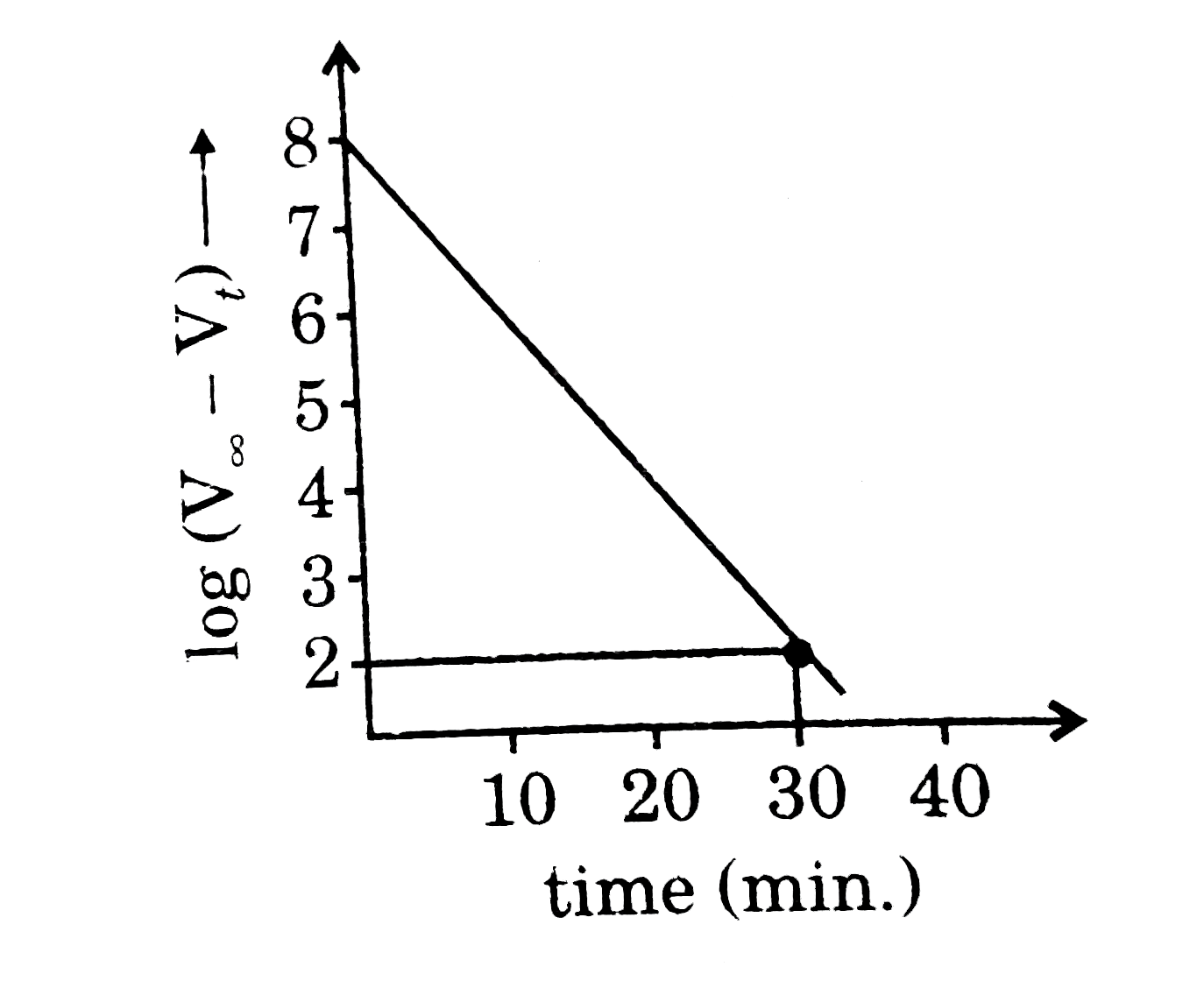Benzene diazonium chloride (A) decoposes into chlorobenzene (B) and N2 (g) in first order reaction. Volumes of N2 collected after 5 min and at the complete decomposition of A are 10 mL. and 50mL respectively. The are constant for the reaction is Solution in Telugu
0.446min−1
0.0446min−1
0.223min−1
0.112min(−1)
The correct Answer is:B
C6H5N2Cl(A)→C6H5Cl+N2(g),K=2.3035×log5040=2.303×0.09705=0.044637
Topper's Solved these Questions
- CHEMICAL KINETICSBOOK - AAKASH SERIESCHAPTER - CHEMICAL KINETICSEXERCISE - PRACTICE SHEET-1 (LINKED COMPREHENSION TYPE QUESTIONS)
6 Videos
- CHEMICAL KINETICSBOOK - AAKASH SERIESCHAPTER - CHEMICAL KINETICSEXERCISE - PRACTICE SHEET-1 (MATCH THE FOLLOWING QUESTIONS)
2 Videos
- CHEMICAL KINETICSBOOK - AAKASH SERIESCHAPTER - CHEMICAL KINETICSEXERCISE - LEVEL-II(LECTURE SHEET EXERCISE-IV INTEGER ANSWER TYPE QUESTIONS)
10 Videos
- CHEMICAL KINETCSBOOK - AAKASH SERIESCHAPTER - CHEMICAL KINETCSEXERCISE - EXERCISE - 3.2
45 Videos
- CHEMICAL THERMODYNAMICSBOOK - AAKASH SERIESCHAPTER - CHEMICAL THERMODYNAMICSEXERCISE - Additional Practice Exercise
54 Videos
Similar Questions
The instantaneous rate of an elementary chamical reactkon aA+bB⇔cC+dD can be given by rate =Kf[A]a[B]b−Kb[C]c[D]d where Kf and Kb are rate constants for forward and backward reactions respectively for the reversible reaction. If the reaction is an irreversible one, the rate is expressed as, rate =K[A]a[B]b where K is rate contant for the given irreversible rate of disappearance of A is a/b times the rate of disappearance of B. The variation of rate constant K with temperature is expressed in terms of Arrhenius equation: K=Ae−Ea/RT whereas the ratio KfKb is expressed in terms of van't Hoff isochore: KfKb=Ae−ΔH/RT, where Ea and ΔH are energy of activation and heat of reaction respectively.
The variation of rate constant K and KfKb with temperature shows the following effects:
For endothrmic reaction when T increases then K increases and KfKb also increases.
(ii) For endothemic reaction when T decreases then K decreases and KfKb also decreases.
(iii) For exothermic when T increases then K and KfKb both increases.
(iv) For exothermic reaction when T decreases then K increases and KfKb decrease.
(v) For exothermic reaction when T increases thenK and KfKb both decrease.
View SolutionMatch the following columns

View SolutionFor the reaction A→ products the following dats is given for a particular run
time (in): 0 5 15 35
1[A](M−1):1 2 4 8
Determine the order of the reaction.
View SolutionDiscuss on the kinetic spontaneity of a chemical reaction. Is a slow reaction spontaneous? Why?
View SolutionWhich among the following is not an exact differential?
View SolutionThe half life of decompoistion of N2O5 is a first order reaction represented by N2O5→N2O4+1/2O2
After 15min the volume of O2 profuced is 9ml and at the end of the reaction 35ml. The rate constant is equal to
View SolutionThe compoistion of N_(2)O_(5) is a first order reaction represented by: N_(2)O_(5) rarr N_(2)O_(4) + 1//2O_(2) . After 20 min the volume of O_(2) profuced is 10 mL and at the end of the reaction 40 mL . The rate constant is equal to
View SolutionIn the reaction NH4NO2(aq.)→N2(g)+2H2O(l) the volume of N2 after 20 min and after a long time is 40ml and 70ml respectively, The value of rate constant is :
View SolutionDecomposition of NH4NO2(aq into N2(g) and 2H2O(l) is first order reaction.
View SolutionFor the first order reaction

Following observation is made: where Vt (in ml) is volume of N2 collected at time t and V∞ (in ml) is volume of N2 collected after a long time. what is the time taken (in minutes) for 75% reaction completion? (log 2=0.3)

View SolutionThe decomposition of N_(2)O_(5) is a first order reaction represented by N_(2)O_(5) rarr N_(2)O_(4)+1/2 O_(2) After 15 minutes the volume of O_(2) produced is 9 cc and at the end of the reaction 35 cc The rate constant is equal to
View SolutionBenzene diazonium chloride in aqueous solution decomposes according to the equation C^(6)H^(5)N^(2)Cl rarr C_(6)H_(5)Cl+N_(2) Starting with an initial concentration of 10 g L^(-1) , the volume of N_(2) gas obtained at 50^(@)C at different intervals of time was found to be as under : {:("t (min)":,6,12,18,24,30,oo),("Vol. of "N_(2) (ml):,19.3,32.6,41.3,46.5,50.4,58.3):} Show that the above reaction follows the first order kinetic. What is the value of the rate constant ?
View SolutionDecomposition of N_(2)O_(5) in liquid "CCl"_(4) is a first order reaction : 2N_(2)O_(5)rarr4NO_(2)+O_(2) . The rate constant for this reaction is 3.66xx10^(-2) "min"^(-1) . Determine the reaction -rate when the concentration of N_(2)O_(5)=3.15"mol .L"^(-1)
View SolutionDecomposition of N2O5 in liquid CCl4 is a first order reaction : 2N2O5→4NO2+O2 . The rate constant for this reaction is 3.66×10−2min−1.
At what concentration of N2O5 will the reaction -rate be 3.854×10−2mol.L−1.min−1 ?
View SolutionN2O5 का अपघटन एक प्रथम कोटि की अभिक्रिया है जिसे इस समीकरण द्वारा प्रदर्शित करते हैं N2O5→N2O4+½O2,15 मिनट के बाद O2 का आयतन 9 मि.ली. तथा अभिक्रिया के अन्त में प्राप्त O2 का आयतन 35 मि.ली. है। वेग नियतांक का मान है
View Solution
